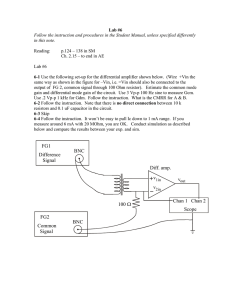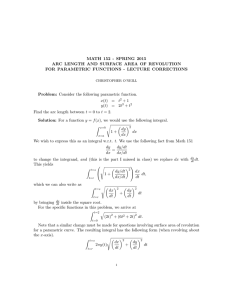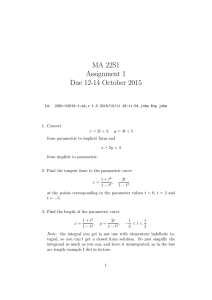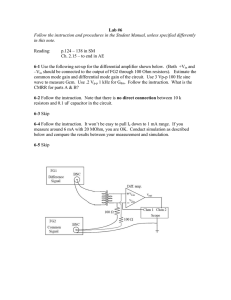FIC in R
advertisement
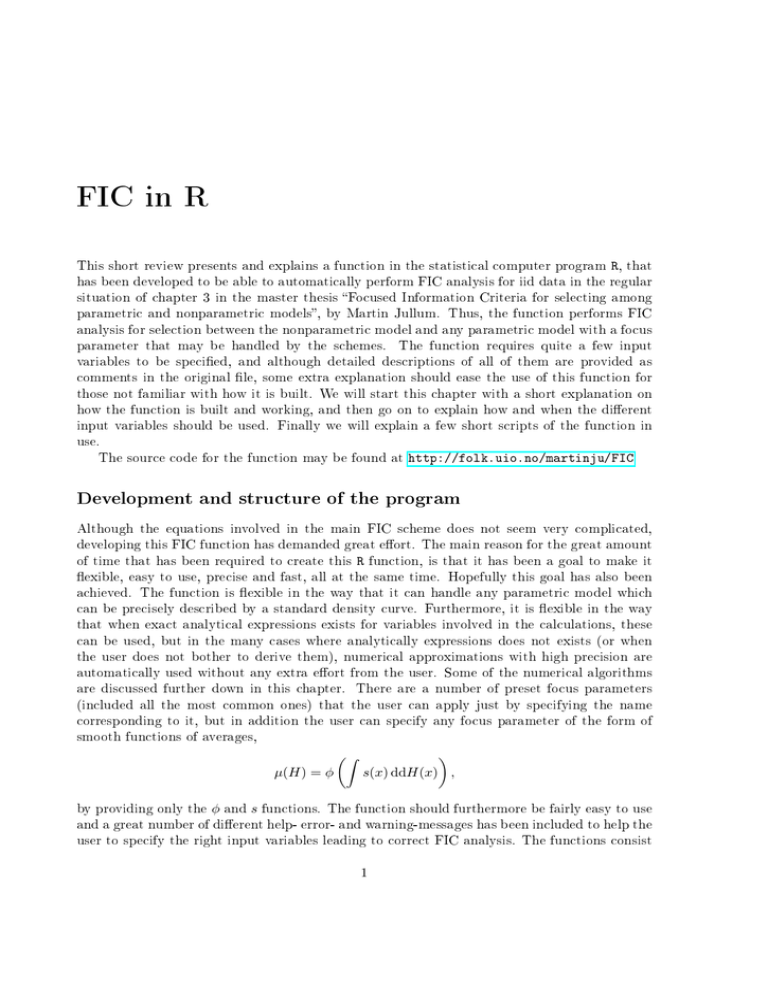
FIC in R
This short review presents and explains a function in the statistical computer program
R,
that
has been developed to be able to automatically perform FIC analysis for iid data in the regular
situation of chapter 3 in the master thesis Focused Information Criteria for selecting among
parametric and nonparametric models, by Martin Jullum. Thus, the function performs FIC
analysis for selection between the nonparametric model and any parametric model with a focus
parameter that may be handled by the schemes.
The function requires quite a few input
variables to be specied, and although detailed descriptions of all of them are provided as
comments in the original le, some extra explanation should ease the use of this function for
those not familiar with how it is built. We will start this chapter with a short explanation on
how the function is built and working, and then go on to explain how and when the dierent
input variables should be used. Finally we will explain a few short scripts of the function in
use.
The source code for the function may be found at
http://folk.uio.no/martinju/FIC.
Development and structure of the program
Although the equations involved in the main FIC scheme does not seem very complicated,
developing this FIC function has demanded great eort. The main reason for the great amount
of time that has been required to create this
R
function, is that it has been a goal to make it
exible, easy to use, precise and fast, all at the same time. Hopefully this goal has also been
achieved. The function is exible in the way that it can handle any parametric model which
can be precisely described by a standard density curve. Furthermore, it is exible in the way
that when exact analytical expressions exists for variables involved in the calculations, these
can be used, but in the many cases where analytically expressions does not exists (or when
the user does not bother to derive them), numerical approximations with high precision are
automatically used without any extra eort from the user. Some of the numerical algorithms
are discussed further down in this chapter.
There are a number of preset focus parameters
(included all the most common ones) that the user can apply just by specifying the name
corresponding to it, but in addition the user can specify any focus parameter of the form of
smooth functions of averages,
Z
µ(H) = φ
by providing only the
φ
and
s
s(x) ddH(x) ,
functions. The function should furthermore be fairly easy to use
and a great number of dierent help- error- and warning-messages has been included to help the
user to specify the right input variables leading to correct FIC analysis. The functions consist
1
of over 1300 lines of code.
Most of the code is just denitions and checks that everything
is working as it should, nonetheless some computations takes time.
To reduce the time of
computations, vectorized objects are used all the way rather than looping in spirit of good
programming. However, when it comes to numerical approximations, speed and precision does
not go hand-in-hand. Getting precise results has been given the highest priority here to make
sure that the produced results are reliable. In most cases, the extra time needed to be more
precise, is anyway a matter of seconds, not minutes or hours. Finally, the function is tested on
a wide range of problems, a great number of bugs are xed and correct and the current version
appears stable. Nonetheless, bugs might very well appear and there is no guarantee connected
to the produced results.
The function and its input variables
We are now going to explain the input arguments of the function and how the function operates.
For a more comprehensive and detailed walkthrough, we refer to the actual script code with
comments.
In
R
the function appears as below:
FICfunc
FICfunc=function(Data,data.type="cont",FICmethod="standard",numerical=NULL,focus.preset="mean",
focus.preset.extra=NULL,focus.user=NULL,parmodels.preset="gaussian",parmodels.user=NULL,
MLestimates=NULL,print.res=TRUE,print.warnings=TRUE,make.plot=TRUE)
The great number of input variables is due to the exibility of the function. Note however
that in simplest and most straight forward cases, just a few of these arguments needs to be
specied, since the default values of them produces the desired type of analysis.
The main
output of the function is a nice looking table with the key values of the scheme. In addition,
warning messages pointing out possible strange behavior of results (such as negative squared
bias estimate), and a plot of a histogram and the tted density curves of the parametric
distributions are also provided. Also, everything that is calculated in the function and all input
variables are stored in objects the user can investigate further if interested.
The functions
running time before giving the output are also timed and saved in an object.
It is now time to give a short overview on how the function operates. When sourcing (or
loading) the function code, the code checks if the package
numDeriv with functions performing
numerical derivation using well-tested and precise methods, is installed and loaded, if not, this
is done.
The rst part of the actual FIC function contains a number of
if-tests
to check
that each of the input arguments are given on the correct form. In the cases where they are
not on the correct form or provided, the function stops and gives a help message to help the
user specify it correctly. Then the function checks if the combination of the input arguments
and objects match each other. The next part of the FIC function contains denitions of the
functions that are used in the actual calculations later on. The calculations are then performed
for the nonparametric and all the parametric models according to how the user has specied
that this should be done in the input arguments. Finally, these results are stored in convenient
objects, and results are printed together with possible warning messages and the plot of the
histogram and the tted parametric density curves.
We now turn to the input arguments of the FIC function. The arguments of the function
are explained in the following list:
2
Data:
A required numeric argument of any positive length. This is the data set to be
evaluated by the function. Any numbers can be given to it (NA and nan are removed)
data.type:
A character of length 1. This argument decides wether the data should be
treated as continuous or discrete. The parametric models tted must be of the same type.
Either
"cont" (default) or "disc" can be inserted.
The former corresponds to continuous
data and the latter to discrete.
FICmethod:
A character of length 1. This decides which FIC formula that should be used
in this setting.
Either
"standard"
(default) or
"standard_adj"
can be inserted.
The
former gives the main scheme, whereas the latter gives the version adjusting for possible
negative squared bias and variance estimates.
numerical:
An vector of characters of any length or
NULL. The object species what part
NULL, all calculations
of the calculation that should be done numerical. If this is set to
are done exact (as far as possible). If the vector includes
"deriv" the derivation of the focus parameter with respect to the parameters of the
parametric models are done numerically.
"score" the score function is calculated numerically.
"info" the information function is calculated numerically.
focus.preset:
A character of length 1 or
NULL. This argument species which (if any) of
the preset focus parameters that shall be used. The user can choose any of the following
preset focus parameters
"madam"
and
"IQR".
focus.preset.extra:
"median", "quantile", "mean", "var", "sd", "cumulative",
A numeric of length 1 or
NULL. The argument is used to specify an
additional argument to the preset focus parameter (if necessary). Especially it is required
when
focus.preset is set to "quantile" "cumulative" or "prob.mass", to specify which
point of that is of interest. The argument is not used for other focus parameters.
focus.userR A list or NULL
. The argument species any so-called smooth focus parameter
µ(H) = φ s(x)dH(x) , of the users choice. NULL is default. The list must contain the
following arguments:
name: A character of length 1 giving the name of the focus parameter,
s: A function of 1 argument specifying the s function.
phi: A function of 1 argument specifying the φ function.
parmodels.preset:
A vector of characters of any length or
NULL.
The argument spec-
ies which (if any) of the preset parametric models that should be tted.
"gaussian"
is included in the model selection scheme when
and none is included when it is set to
"disc".
data.type
By default
is set to
"cont",
As of September 2012, this distribution is
also the only preset distribution that is included.
MLestimates:
A list of vectors or
of the parametric models.
NULL.
The argument species the tted ML-estimates
This is particularly useful when tting a parametric model
where analytic expressions for the ML-estimators does not exist, e.g. for the gamma or
3
weibull distributions. In those cases an
nlm
algorithm may be applied rst to nd the
ML-estimates numerically before this FICfunc is used more on this in the next section.
parmodels.user:
the users choice.
A list of lists or
NULL
NULL. The argument species any parametric model of
is the default, meaning that no parametric model other than the
preset one, is included. To specify parametric models, this list must contain a new list
for each new parametric model. The name of the new list is the name of the model, and
it must contain arguments depending on how the focus parameter is specied or which
parts of the calculation that should be solved numerically. The following objects is by
always required:
dim:
pdf:
A numeric of length 1 specifying the dimension of the parametric model.
A function of the evaluation point and the parameter values (2 arguments)
returning the probability distribution.
log.pdf:
The same as
pdf
but the logarithm of the function value is returned
instead.
In addition the following objects are required depending on other input variables:
cdf:
A function the evaluation point and the parameter values (2 arguments) re-
turning the cdf, is required for any non-smooth focus parameter.
ML: A function of the data (1 argument) returning the ML-estimates is required when
MLestimates
does not include a vector corresponding to this particular parametric
model.
deriv$(name of the focus parameter):
A function of the parameter value (1 ar-
gument) returning the derivative of the focus parameter w.r.t.
the parametric model, is required if not
score:
"deriv"
is included in
the parameters of
numerical.
A function of the data point value and the parameter values (2 arguments)
returning the score function of the parametric model, is required if not
included in
info:
numerical.
"score"
A function of the data point value and the parameter values (2 arguments)
returning the information function of the parametric model, is required if not
is included in
eval. set:
numerical.
data.type="disc".
A function of the eval.set and the parameter values (2 arguments) returning
the probability mass for a discrete distribution. Required if
qdf:
"info"
A numeric of any positive length specifying the evaluation points for a
discrete distribution. Required if
pdf:
is
data.type="disc".
A function of the eval.set and parameter values (2 arguments) returning quan-
tile function for a discrete distribution function. Required if
focus.type!="smooth".
print.res:
A logical argument (TRUE or
FALSE).
data.type="disc" and
The argument species if the results
should be printed to the terminal or not. This is useful if
FICfunc are used repeatedly for
simulation studies or similar, where the result table of every execution is not of interest.
The default is
TRUE.
4
print.warnings:
printed or not.
A logical argument.
The argument species if warnings should be
This can also be useful in simulation studies or whenever unnecessary
printing should be omitted. The default is
make.plot:
TRUE.
A logical object. It species if a histogram with plotted density curves of the
parametric distribution should be plotted or not. The default is
TRUE.
Note that exactly one focus parameter must be specied. If several focus parameters are
of interest, simply run the function again with changed focus. Also, either tted ML-estimates
MLestimates or
parmodels.user$ML.
must be provided through
must be provided by
a function producing these values from the data
In addition to printing a table with the summary results from running the scheme, the
function also stores many of the intermediate results obtained while running.
This may be
particularly useful to validate the results or to investigate what caused the particular output.
Also, when using the fucntion for simulation purposes this is useful.
Numerical algorithms
Some situations are not solvable without numerical approximations.
This concerns mainly
quantities which are based on dierentiation or integration. Since accuracy is important in this
situation, we do not try to build something clever on our own, but rely on built-in algorithms
in the statistical programming language
R
instead, implemented by people with much better
knowledge of this. For numerical dierentiation, we will use the functions
of the package
numDeriv
and the method
"Richardson",
grad
and
jacobian
which uses so-called Richardson ex-
trapolation. Although Richardson extrapolation is not the fastest method available, but it is
known to be of the most precise and reliable methods, which is way we chose to use exactly
this method.
Numerical integration using the function
integrate
in
r
performs one-dimensional numer-
ical integration based on the so-called QUADPACK-routine. This works out fairly well by
placing an additional simple self-made algorithm, wisely choosing the integration bounds in
each situations.
More on these numerical derivation and integration techniques can be found in any book
on numerical analysis [xx: Bør vel kanskje nne en eller annen referanse her?]
The program in use
We nish o this short chapter by providing a few examples of
FICfunc
in use. We start out
with possibly the simplest meaningfull example one could think of: Testing whether a normal
distribution or the nonparametric model is best at estimating the median of a data set. The test
data are provided by simulating a set of 100 variables from the standard normal distribution.
To perform this task, we run the following simple code in
R:
Command line arguments
source("http://folk.uio.no/martinju/FIC/source_code/FICfunc.final.final.R")
# The simplest test ever
set.seed(321)
data=rnorm(100)
# Loading the FIC function
# Setting some seed-level to ease reproduction.
# Simulate the data
Test=FICfunc(data,focus.preset="median")
# Running the FIC function
5
When executed
FICfunc
prints the following output:
Output
> Test=FICfunc(data,focus.preset="median")
mu dim
bias*
sd
RMSE
Nonpar 0.086579255 Inf 0.00000000 0.11224232 0.11224232
Gaussian 0.009067669
2 0.03029794 0.09509784 0.09980764
Rank
2
1
Warning: To estimate the influence values of the median, a non-plug-in estimation procedure has been
used to estimate the density at the focus parameter g(mu). The function "density" with
the default bandwith in R is used to do this.
As we see a nice and hopefully intuitive table is printed. On the far left the model name
is given, furthermore,
mu
denotes the estimates of the focus parameter,
dim
the number of
parameters in the model (where the nonparametric is always set to 0). Then the key estimation
results of squared bias and variance are brought back to scale by taking the root of the estimates.
The reason for this is that it is easier to compare the sizes of them when they are on the same
scale as
and
sd
µ.
Thus,
bias*
is the square root of the absolute value of the squared value estimate
is simply the square root of the variance estimates. Moreover,
RMSE
denotes the square
root of the FIC scores. Once again the square root is taken to make it easier to compare the
sizes of the terms. Finally, the last column gives the ranking of the models. Below the table a
warning message has been given, since a estimation dierent from the usual plug-in technique
has been used. When the adjusted scheme is used instead, a subscript adj is added to the
terms
bias* sd
and
RMSE
to mark that the formulae are adjusted.
We are now going to show how a bit more complicated model selection task can be handled
by this function. We will use an example from the theis concerning the Norwegian population's
activity level. For this situations we have data on the number of daily steps for each person
and are interested in the proportion of the population that walks more than 10 000 steps. Thus
the focus parameter is
µ(H) = 1 − H(10000) for a cdf H .
This focus parameter is not available
as one of the preset focus parameters, so we must manually specify it rst. However, the focus
parameter is clearly on the smooth form and specied by
In
R
s(y) = 1{y≥10000} (y)
and
φ(y) = y .
we dene the following functions to deal with this:
focus.user=list()
focus.user$name="Proportion"
focus.user$s=function(val)
{
(val>=10000)
}
Focus parameter definition
focus.user$phi=function(val)
{
val
}
Furthermore, we included three dierent parametric model in the set of candidate models,
where only the Gaussian model is preset in the FIC function. Thus, we have to do just a bit of
work rst to apply the two other parametric distribution. Firstly the lognormal distribution is
to be added. Since the ML-estimator for this parametric distribution can be found analytically,
it is preferred to calculate them and include them as formulae.
The following script denes
the list of functions need for the lognormal distribution to be included in the set of candidate
models:
6
# Adding the lognormal distribution
Adding the lognormal distribution
parmodels.user.list=list()
parmodels.user.list$lognormal$dim=2
parmodels.user.list$lognormal$pdf=function(val,para)
{
(val>0)*dlnorm(val,para[1],para[2])
}
parmodels.user.list$lognormal$log.pdf=function(val,para)
{
(val>0)*dlnorm(val,para[1],para[2],log=TRUE)
}
parmodels.user.list$lognormal$ML=function(data)
{
c(mean(log(data)),sd(log(data)))
}
For the skewed normal distribution, however, there exists no analytical formula for the MLestimator.
Therefore, the
nlm
function which is performs nonlinear minimization, is applied
to nd the maximum of the log-likelihood function.
Some trial-and-failure might be needed
concerning starting values of the numerical algorithm.
straight forward.
In this example it is however pretty
Before we can run this algorithm we dene the necessary function of the
skewed normal distribution by importing the package
sn.
Adding the skewed normal distribution
# Includes the skewed normal distribution
#install.packages("sn")
library("sn")
parmodels.user.list$sn$dim=3
# Installs the skew normal distribution.
parmodels.user.list$sn$pdf=function(val,para)
{
dsn(val,dp=para)
}
parmodels.user.list$sn$log.pdf=function(val,para)
{
dsn(val,dp=para,log=TRUE)
}
# Estimates the parametric parameters with the nlm function
minloglik.sn=function(para)
{
-sum(parmodels.user.list$sn$log.pdf(data,para))
}
nlm.sn=nlm(minloglik.sn,c(mean(data)+100,sd(data)+100,shape=1),gradtol=10^(-15),steptol=10^(-15))
nlm.sn$code
# Printing the code to check that the nlm function has converged correctly.
MLest=list()
MLest$sn=nlm.sn$estimate
Now, as the focus parameter is dened along with all the necessary denitions for the
parametric models, we can apply the FIC function to this problem by inserting arguments
corresponding to the FIC analysis we wish to run.
Executing FICfunc for example 1
FIC_steps=FICfunc(Data=data,FICmethod="standard",numerical=c("deriv","score","info"),focus.preset=NULL,
focus.user=focus.user,parmodels.preset="Gaussian",parmodels.user=parmodels.user.list,MLestimates=MLest)
7
Note that both derivation with respect to the parameters in the parametric models and
nding the score and information functions are done numerically in this situation.
For the
lognormal distribution we could have found analytical expressions for these quantities, but we
expect it to be hard for the skewed normal distribution, and therefore decided to use numerical
algorithms instead. The use of numerical algorithms do however increase the execution time
of the function, but even if the amount of data are not small here, it all takes less than half a
minute on a lightweight modern laptop. As seen in the above scripts, some more work has to be
done in advance of executing the FIC function, and some more arguments needs to be specied
compared to the rst simple situation of the median. Still we believe this is not overwhelming
for most statistical researchers.
8
